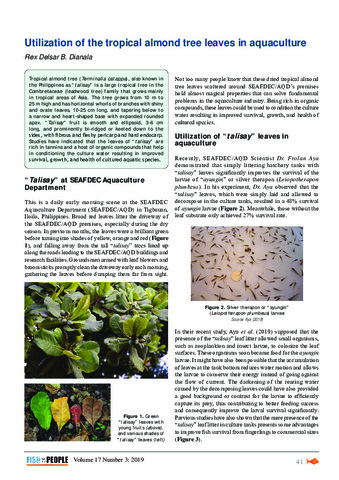Utilization of the tropical almond tree leaves in aquaculture
- Global styles
- MLA
- Vancouver
- Elsevier - Harvard
- APA
- Help

View/
Date
2019Author
Page views
27,483ASFA keyword
AGROVOC keyword
Taxonomic term
Metadata
Show full item record
Share
Abstract
Tropical almond tree (Terminalia catappa), also known in the Philippines as “talisay” is a large tropical tree in the Combretaceae (leadwood tree) family that grows mainly in tropical areas of Asia. The tree grows from 10 m to 25 m high and has horizontal whorls of branches with shiny and ovate leaves, 10-25 cm long, and tapering below to a narrow and heart-shaped base with expanded rounded apex. “Talisay” fruit is smooth and ellipsoid, 3-6 cm long, and prominently bi-ridged or keeled down to the sides, with fibrous and fleshy pericarp and hard endocarp. Studies have indicated that the leaves of “talisay” are rich in tannins and a host of organic compounds that help in conditioning the culture water resulting in improved survival, growth, and health of cultured aquatic species.
Suggested Citation
Dianala, R. D. B. (2019). Utilization of the tropical almond tree leaves in aquaculture. Fish for the People , 17(3), 41-43. http://hdl.handle.net/20.500.12066/5794
Type
magazineArticleCollections
- Fish for the People [41]



